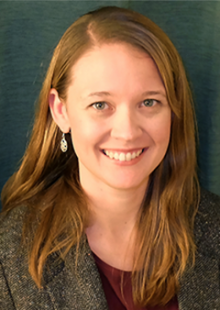
By Yvonne Medina
Dr. Blair Brettmann, Solvay Faculty Fellow and Raymond and Stephanie Myers Faculty Fellow, brings a wealth of industry experience to her teaching and research at Georgia Tech. This industry experience introduced Dr. Brettmann to materials science, where she has created coatings for windshields and architectural fabrics among her numerous projects. In industry, she enjoyed exposure to a wide variety of products and gained a great deal of experience, but she missed some aspects of academia such as the time to do deep dives into underlying scientific processes and mentoring students.
She brings this industry experience to both her graduate and undergraduate classes to prepare students for on-the-job problem solving. The principles she focuses on in these classes include teaching students to think about the whole process of developing a product, which students will have to do when they commercialize products in industry. The questions she asks are how do these new materials impact how well you can process and manufacture the product?
She encourages students to think about the entire process as a set of integrated parts. To do this, she examines the whole cycle of a product from beginning to end, the links between the various stages of processing, and how the material flows and solidifies during processing with the goal of speeding up product development. This requires understanding the fundamentals of the material to decide if it is scalable, and if so, how to scale it so we can avoid or minimize the traditional, hard won approach of trial and error.
In her undergraduate courses, Dr. Brettmann says, “I like to bring in realistic activities to the classroom instead of just talking about practical applications of a specific polymer.” For example, she gives students data sheets about a polymer resin, the same resin booklets that they will have to consult in industry. Then, they have to decide what resin to use as well as its formulation and how to process it. These innovations in teaching have led to her proudest professional achievement, an Outstanding Undergraduate Research Mentoring Award she received at Georgia Tech.
Her current research ranges from ultrafine fibers, pharmaceuticals, pulp and paper manufacturing, and 3D printing on the moon. This last project explores binding materials that would enable lunar dust to flow through a printer and allow astronauts to 3D print on the moon. Some tricky factors here include the moon’s extremely low temperature, microgravity, and lack of oxygen. She has partnered with the NASA Marshall Space Flight Center in Alabama to pursue this exciting project.
In her new role as the current editor at ACS Applied Polymer Materials, she looks forward to continuing to encourage submissions and advise on polymer processing and application. However, she is also looking forward to focusing on the bigger picture of sustainable polymer materials and designing polymers for circularity. She integrates more life cycle analysis into all of her projects because her former students are being asked to do life cycle analysis in industry.
While plastics are essential for modern life, she explains, from technology to food safety, for example, they are not generally designed for an end of life. She asks, “how do we source polymers from more sustainable sources like waste or renewable sources, and how do we design the polymers such that after we're done using them, we can recycle them or turn them back into monomers and reuse them? How do we design for a product’s end of life?” These pressing questions will be one area of focus for the journal. A lot of these new polymers aren’t financially feasible or they don’t have great properties. Dr. Brettman’s editorial role will help drive this research forward.
Dr. Brettmann’s career has included work on a huge variety of materials and a commitment to thinking about the product’s processing, life cycle, and sustainability. She brings this holistic way of thinking to her teaching which prepares students for industry while also driving innovation forward in the exciting field of sustainable polymers.